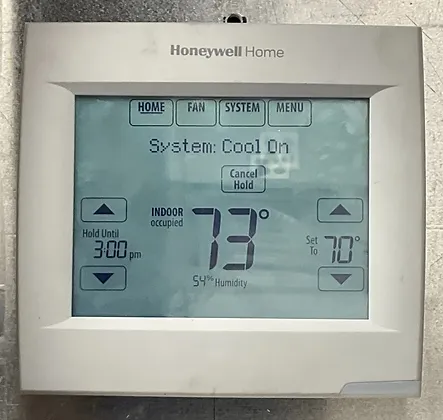Thermostats

Thermostats are ubiquitous in our everyday life: your home, your work, your car. While they may be different, they all have the same function in keeping the temperature consistent. In cars, it’s used to control coolant to maintain an ideal engine temperature for fuel efficiency. Similarly, thermostats in HVAC control the AC system to maintain a given temperature in your home. They can be classified into 3 primary categories: Programable, Non-Programable, and Smart.
Non-Programable Thermostats
These thermostats fall into two types: mechanical and digital. Mechanical often make use of bimetallic strips. These are comprised of two types of metal that expand and contract at different rates depending on temperature. Bimetallic strips move to either turn off or on your AC system, depending on their setting and temperature. Mechanical thermostats are cheaper than others and can be ideal for locations prone to power surges. Digital non-programmable operate on the same principle as mechanical, but use digital sensors to detect temperature changes. These are generally more expensive than their mechanical counterparts but have greater accuracy and respond to temperature changes better.
Programable
Programmable thermostats have the same functionality as a digital non-programmable, but allow you to program them for days or times. For instance, you may be at work Monday through Friday and stay home on the weekends. You can set the temperature higher during the day but have the AC system turn on before you get home. Since your AC unit will run less, you won’t put as much wear and tear on the system. Additionally, you’ll save money on your energy bill.
Smart Thermostats
Smart thermostats are primarily defined by their ability to automatically adjust to your habits or, if there are other sensors in your house, be able to detect your presence and cool the rooms individually to maximize energy efficiency. These often have the same functionality as programmable thermostats, allowing you to program for different days or times of the day. Often more expensive than other thermostats, smart thermostats can save you money in the long term with energy efficiency. Some have additional features such as wireless connectivity, allowing you to connect and adjust the temperature from your phone, tablet, or computer.
Troubleshooting Issues
- Common issues with thermostats include:
- -The display is blank when it is powered on and / or does not turn on the AC when adjusted. It is a good idea to try changing the batteries and if issues still persist after changing the batteries, we would recommend scheduling with us to have one of our technicians review the issue.
- -If your AC is not turning off or is not turning on despite switching it on or off from your thermostat, try changing the batteries. If the issue still persists it is possible there may be a wiring fault, defect, or similar. While changing the batteries, check for any dust. Dust can cause electrical shorts and has the potential to damage electrical components.
- -If you notice the temperature is abnormally hotter or cooler than what you set your thermostat to, it might indicate that it is unable to accurately measure the room’s temperature. If the thermostat is located in the path of direct sunlight or similar, the thermostat could have an inaccurate reading. If the thermostat location is not the issue, you can place a working thermometer nearby to verify an accurate reading. If the thermostat is not getting an accurate reading, we would recommend scheduling with us to have one of our technicians review the issue.




